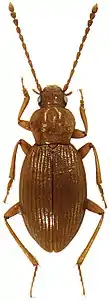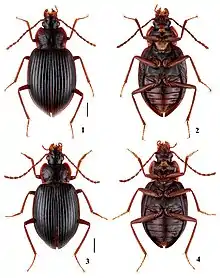| Agyrtidae Temporal range: | |
|---|---|
_(14954636326)_(cropped).png.webp) | |
| Necrophilus subterraneus (Necrophillinae) | |
 | |
| Male specimen of Lyrosoma pallidum (Agyrtinae) | |
| Scientific classification | |
| Domain: | Eukaryota |
| Kingdom: | Animalia |
| Phylum: | Arthropoda |
| Class: | Insecta |
| Order: | Coleoptera |
| Suborder: | Polyphaga |
| Infraorder: | Staphyliniformia |
| Superfamily: | Staphylinoidea |
| Family: | Agyrtidae Thomson, 1859 |
| Subfamilies | |
|
Agyrtinae | |
Agyrtidae, or primitive carrion beetles, are a small family of beetles belonging to Staphylinoidea. They are found in mostly temperate areas of the Northern Hemisphere and in New Zealand.
Characteristics

Agyrtidae are small or middle-sized beetles (length 4–14 mm). They have usually oval body, but the Pterolomatinae are superficially similar to ground beetles. Abdomen is with five visible ventral sclerites, procoxal cavities internally open. Hindwings have anal lobe but no radial hinge.[1]
Ecology
The group have a diverse ecological habits, but appear to be mostly saprophagous. Necrophilinae is attracted to decaying material including carrion, rotting fungi and dung, in the vicinity of temperate forests. Agyrtinae have a diverse variety of habits, with the genus Lyrosoma being found on cold beaches of the North Pacific rim, where they have been found feeding on kelp and dead seabirds, while Ipelates is associated with decaying logs and fungi, leaf litter, vegetation and flowers. Pterolomatinae appears to be active predators, with Pteroloma having been found in wet and boggy habitats, especially cold mountain streams. Some Apteroloma species are found abundantly in mountain habitats, while others are found in open or forested areas.[2]
Fossil record
The oldest unambiguous members of the family are from the Early Cretaceous of Asia, including Ponomarenkia from the Turga Formation and Palаeonecrophilus from the Khasurty locality, both of which are located in Buryatia in Russia, and date the Aptian stage (~125–113 million years ago). The latter can be assigned to the modern subfamily Necrophilinae. Earlier claimed Jurassic records, such as Mesagyrtes and Mesecanus from the Middle Jurassic of China, require re-evaluation.[3]
Systematics
Currently, about 60 species are known. The family is divided into three subfamilies:
- Agyrtinae
- Necrophilinae
- Necrophilus (Western Palearctic, Oriental, and Nearctic)
- Zeanecrophilus (New Zealand)
- Pterolomatinae
- Apteroloma (Nearctic, Palearctic, Neotropical, Oriental Realms)
- Pteroloma (Nearctic, Palearctic)
Until recently, species of this family had been included in the family Silphidae (as tribes Lyrosomatini and Agyrtini), but are now considered more closely related to the family Leiodidae.[4]
References
- ↑ M.Hansen. Phylogeny and classification of the staphyliniform beetle families (Coleoptera). Biologiske Skrifter 48, Copenhagen, 1997
- ↑ "Agyrtidae Thomson, 1859". Handbook of Zoology Online. De Gruyter. Retrieved 2022-10-02.
- ↑ Strelnikova, O. D.; Yan, E. V.; Vasilenko, D. V. (November 2020). "A New Agyrtid Beetle (Coleoptera, Agyrtidae) from the Lower Cretaceous Khasurty Locality". Paleontological Journal. 54 (6): 627–631. doi:10.1134/S003103012006009X. ISSN 0031-0301. S2CID 227133080.
- ↑ Lawrence,J.F. & Newton,A.F., Jr. Evolution and classification of beetles. Annu. Rev. of Ecology and Systematics 13, 1982.